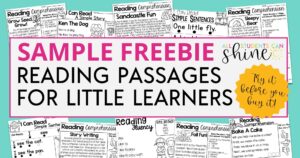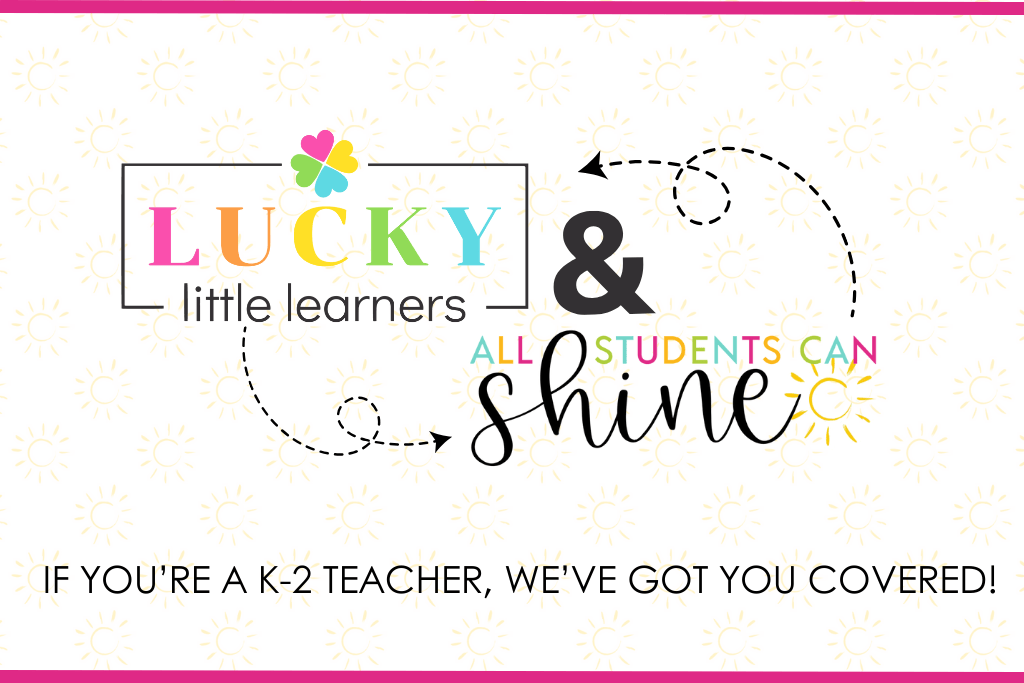Reading and writing literacy for our young students is one of the most important and fundamental skills to master. Building an understanding of the difference between letters, words, and sentences is a complex process. It takes lots of exposure, lots of practice, and most of all, lots of opportunities to apply what they’ve learned in meaningful ways.
As adults, we take sentence writing for granted, but it’s really quite complex! Students have to master all of these steps:
- How to recognize letter shapes and sounds
- Understand how those letters form words with certain meanings
- Combine words to form complete sentences with different parts
- Recognize that together those parts of a sentence make a complete idea
That’s a lot! Luckily there are tons of useful strategies to help you get your students where they need to be when it comes to primary literacy.
If you have pre-readers and need resources for sight words and phonics practice, check out the resources I have in these previous blog posts:
- Reading Fluency Practice for Early Readers
- Effective Strategies for Teaching Sight Words to Primary Students
- HANDS-ON LEARNING – TRANSFORM YOUR READING INSTRUCTION & SEE RESULTS!
Once your students reach the emergent stage, they are ready to read and write sentences.
In this post, we’re going to focus on sentence building strategies and resources to help your young learners grasp the parts and meaning of sentences. Mastering the important early steps of reading and writing sentences leads to stronger writing skills later on. I’m going to share tips and strategies, plus break down the resources I have available to get you started.
A Primary Sentences Bundle You’re Going to Want to See!
There are all kinds of ways you can encourage sentence writing throughout the day in your classroom. To make it a no-brainer, I’ve created this set that includes worksheets and related hands-on activities you can use in centers later. Your little learners can keep applying what they’ve learned until they’ve mastered the skill.
There are 5 activities in this bundle that incorporate color coding, helpful reminders with icons and graphics, and spaces to practice writing sentences using Who, What, When, Where prompts. There is plenty of space for students to independently engage with the skill.
What’s Included:
Activity 1, Find a Sentence: Students color-code words and phrases as they identify the who, what, where/when parts of each sentence. The parts are already ordered in a column under the correct heading, and students will find the parts that go together to form the most logical meaning. Once they build three sentences, they pick their favorite and write it on the line.
Activity 2, Parts of a Sentence: For this activity, sentences are already written, and students will color-code the parts based on the key provided. They will identify who (red), what (yellow), when (blue), and where (green) for each sentence provided.
Activity 3, Build a Sentence: Students will look at the picture provided, and describe what they see by first identifying and writing who, what, when, and where the provided pictures are showing. Then they will combine those parts to create a sentence on the line. There are also icons to remind them to circle the capital letter, check finger spaces, and circle the period. All of these checks will help students make sure they are writing the sentences correctly.
Activity 4, Write a Sentence: This activity is similar to the previous one, except that there are individual pictures for students to identify who, what, when, and where. The icons are included in this one as well to ensure that the students rewrite the sentence correctly.
Activity 5, Sentence Edits: The last activity helps students practice the skill of editing sentences. We want our little learners to understand how to edit and revise their own writing down the road. This activity features sentences that are written incorrectly. Students have to fix them and rewrite them correctly using the icons to make sure they are accurately including capitals, finger spaces and punctuation as well.
Looking for even more value?
Each set of worksheets also comes with a hands-on game. Teachers can use worksheet activities as a guided class lesson, and then use the games in learning centers when kids are ready to practice them on their own.
Want more literacy resources? Have more questions or want to share what works for you and how you differentiate primary concepts in your classroom? Make sure to follow All Students Can Shine on Teachers Pay Teachers, and come visit me on Instagram or Facebook to join the conversation!















